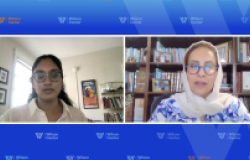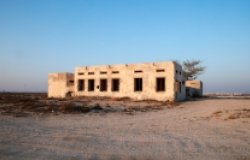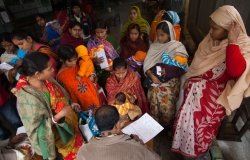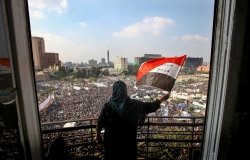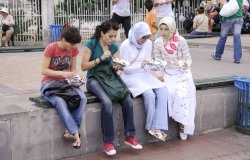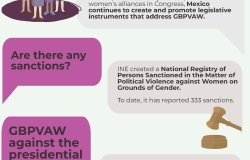Afghanistan Beyond the Headlines: Women, Youth, and War
As the United States approaches its 2014 deadline for military withdrawal from Afghanistan, one often overshadowed aspect of the conflict is the hard-won progress made by previously marginalized segments of the Afghan population, particularly women, girls, and young people. Afghanistan has one of the highest proportions of young people in the world – many of whom have known only war. The median age of the population is 15.6 years old, the median age of marriage is 18, and half of mothers surveyed during a country-wide mortality survey had their first child when they were teenagers.
Overview
As the United States approaches its 2014 deadline for military withdrawal from Afghanistan, one often overshadowed aspect of the conflict is the hard-won progress made by previously marginalized segments of the Afghan population, particularly women, girls, and young people.
Afghanistan has one of the highest proportions of young people in the world—many of whom have known only war. The median age of the population is 15.6 years old, the median age of marriage is 18, and half of mothers surveyed during a country-wide mortality survey had their first child when they were teenagers.
But “while more than 70 percent of Afghanistan’s population are under 25 years of age, young people’s voices are rarely heard,” said Maiwand Rahyab, Counterpart International’s deputy director of Afghanistan.
“Let’s not be naïve about the current reality,” Rahyab said at the Wilson Center. “Afghan society is conservative and hierarchical,” making it difficult for young people to contribute meaningfully to policymaking and government reform. But over the last decade, there have been improvements in schooling, health, and opportunities for young people, which he and other panelists described during a special half-day event on June 24, “Afghanistan Beyond the Headlines: Women, Youth, and the War.”
A New Generation of Engagement
“With all of these challenges, it is easy to believe that it is impossible for youth to mobilize and influence the country’s future,” said Rahyab. “However, I would like to challenge the popular perceptions about Afghanistan,” by showing there is “an emerging generation that is striving to transform a war-torn country into a safer, more secure, and prosperous place to live.”
Two-and-a-half years ago, Rahyab found himself despairing. “My dreams of a peaceful and democratic Afghanistan were fading quickly,” he said:
I was hopeless and was contemplating leaving the country for good. Fortunately, I was engaging on a regular basis with a broad network of young Afghan entrepreneurs, business leaders, civil society activists, and government officials. I eventually realized that I was not alone – that my frustration was shared by many other Afghans. I realized that leaving Afghanistan was not the solution…there was simply too much at stake. I knew at a fundamental level that genuine development in Afghanistan would only be possible if the new generation could collectively advocate for a common vision, values, and goals.
Empowering Afghan youth to advocate for themselves is a crucial investment for the country, said Rahyab, who has since helped organize the Afghan National Youth Policy. Presented to the president in May, the youth policy is a document created with input from more than 500 young people from around the country that outlines legislative strategies to “systematically address” short-, medium-, and long-term youth issues. The goal is “to ensure that investment in young people leads to sustainable and more equitable development of all young women and men,” write the authors.
“Youth movements are changing politics by providing a platform that ties their present and future to a stable and democratic Afghanistan—this is a generation that actively seeks to contribute to their community,” Rahyab said. “This is a sector that has seen tremendous individual and collective maturity over the past decade…becoming more relevant, viable, vocal, and effective.” Some youth organizations have even started refusing international funding to showcase their independence, he said.
Dangerous Demographics?
Historically speaking, Afghanistan’s large proportion of young people—called a “youth bulge” by demographers—presents many challenges to achieving democracy, said the Stimson Center’s Demographer in Residence and ECSP consultant Richard Cincotta.
Without access to education and livelihood opportunities—goals that become increasingly more difficult with each successive generation of growth—“youthful populations are statistically risky populations, and have a high risk of civil conflict and a low probability of attaining high levels of democracy,” he said.
According to Cincotta, youthful populations apply significant pressure to job markets that do not have the means to incorporate new workers. Faced with a large percentage of unemployed and dissatisfied young people, elites are more willing to back an authoritarian regime to maintain stability.
However, increasing levels of education for women is one of the strongest drivers of decreased fertility rates, which can put the country on track to turn a youthful population into an advantage through what demographers call the “demographic dividend.” Already there are major differences in the total fertility rate of Afghan women based on education levels (5.3 children per women for those with no education compared to 3.6 for those with a secondary education), said Cincotta. Further, as experience across the world has shown, when women of all education levels are given a choice in the matter, they tend to have fewer children.
The education and engagement of women is therefore central to a more peaceful and democratic Afghanistan, he said.
Gains for Girls – and Boys – Threatened
“Education is the only way,” agreed Razia Jan, founder of Razia’s Ray of Hope Foundation, who joined the panel via webcast from Kabul. But increasing schooling is challenging in a country with poor infrastructure and a weak central government, especially for girls, who face a legacy of strict segregation and exclusion from the education system. Jan’s foundation works to address the right to education in Kabul with a free private school for girls of all ages.
Since 2008, the Zabuli Education Center has grown from 108 girls to more than 400 girls now enrolled in K-9 education. “There has never been a school for girls in this area; no one ever offered them this option,” Jan said. “When I asked a little girl in kindergarten why she was learning English, she said ‘because it is an international language’…that is what I am putting in their minds.”
The school is contributing to a dramatic rise in education opportunities for women across Afghanistan. “There are now seven million girls going to school,” said Jan. “There are girls that have asked their parents, ‘Please wait until I do my 12th grade before I get married,’ and when they graduate they will be 23 years old.” Though the expansion of education and youth engagement are positive signs for Afghanistan, Jan said she was worried about the recent announcement that the United States was talking with the Taliban as part of peace negotiations. “My concern is about the U.S. negotiating with the Taliban directly,” she said, “these are murderers – how can we fight for 12 years and now shake hands with them?”
“I know these people will never do what they say,” she said. “They put acid on girls and cut their throats just for going to school; they blew up vans of girls going to class.”
Rahyab said the majority of Afghans believe negotiating with the Taliban risks undermining many of the hard-fought gains of the last decade. “I can’t emphasize more the importance of education for young men and young women,” he said. “Access to quality and equitable educational opportunities will transform Afghanistan – it already has.”
“You [Americans] have planted a bush…it is just flowering,” urged Jan, “please don’t take it away before it is too late and we cannot go back.”
From Worst to…Better
A halt in the country’s progress on women’s health may be the first sign of backsliding on many of the gains made over the last decade.
In the last few years, religious rhetoric against many progressive efforts—such as the Elimination of Violence Against Women Law—has notably increased, said Palwasha Kakar, the director of women’s empowerment and development at the Asia Foundation. “We’ve been noticing that men are becoming more and more vocal about women’s clothes, mobility, and there’s been lots of threats towards women who are participating publicly,” she said. This past June, for example, the Afghan parliament removed a legal requirement that women have to make up at least a quarter of provincial elected officials.
“Afghanistan has one of the highest maternal mortality and child mortality rates in the world,” said Ayscha Hamdani, former special adviser and chief of staff to the European Union special representative to Afghanistan. In 2010, the World Bank estimated that 460 women died per 100,000 live births, which is the 22nd highest rate in the world and the 2nd highest outside of sub-Saharan Africa.
Ratha Loganathan, senior Afghanistan health officer at USAID’s Office of Afghanistan and Pakistan Affairs, explained how lack of infrastructure exacerbates high child and maternal mortality rates. “Two-thirds of the women still give birth at home without a midwife or a skilled birth attendant,” she said. “One in thirteen children dies before their first birthday; one in ten children dies before the age of five; and one Afghan woman dies from pregnancy-related causes every two hours.”
USAID’s work since 2002 has therefore been focused on developing these health services, she said:
The health portfolio has empowered women and female health workers at all levels. At the local level more than 7,500 women health workers have been trained, including 3,000 midwives. USAID’s assistance has established a national network of midwifery schools, and as a result, average use of prenatal care has climbed to nearly 40 percent in provinces with midwifery school graduates, compared to 26 percent in provinces that lack such graduates.
“The results of these efforts are remarkable,” said Loganathan. They have contributed to a decline in maternal mortality of 1,600 per 100,000 births to 327; growth in use of modern contraceptives from 10 to 20 percent; decline in total fertility rate from 6.3 to 5.1 children per woman; increase in women reporting at least one antenatal care visit from just 16 percent of the population in 2003 to 60 percent in 2013; and double the use of skilled birth attendants.
In 2012, the country’s first-ever nationally representative survey of demographic and health issues reported major improvements from previous estimates, including a maternal mortality ratio of 327 women per 100,000 live births, nearly a 30 percent decline from 2010 estimates.
Dr. Linda Bartlett, a researcher on Afghanistan from the Johns Hopkins Bloomberg School of Public Health, emphasized that getting communities involved in the selection of women health workers has been crucial to the successes of the last decade. “Local community-based recruitment of health personnel has been very successful…communities are identifying a woman who they trust and they respect, and who commits by signing a document saying that she will go back to that community and provide health services,” she said.
In the Name of Islam
If these improvements are to continue, however, Kakar suggested more engagement with religious leaders may be needed. “The key with engaging men is finding credible ways to engage with them and really engaging with them, not using them,” she said. “We’ve seen a lot of success in engaging men through credible religious leaders by using Islamic frameworks.”
Hamdani said that for the sustainability of women’s health programs—and international development programs in general—it’s important to work within Afghanistan’s cultural parameters. “We ought to use the very religion of Islam, that is currently being used against women, to actually reinforce the position of women,” she said, “Let’s talk about the rights that woman have according to Islam and use this in a positive manner, to give women a greater access to education, to health, and to the basic provisions that they require.”
This kind of engagement is especially crucial as the Taliban appear to be growing bolder. As the Taliban enter southern and eastern Afghanistan, they’re seeing an “ideological war in some of these provinces,” Kakar said:
These Taliban have been starting something we’ve called a “Ramadan initiative.” Two months before Ramadan, they start holding sessions where they talk about religion in the mosques and they invite men and women to come and listen to these. By talking about verses from the Qur’an they try and justify their ideologies that are against a lot of work that civil society has been doing in terms of civic awareness, women’s education, women’s access to health, and women’s access to justice services.
Many Afghan citizens take what the Taliban say seriously, and Kakar believes that may contribute to a recent uptick in Islamist rhetoric. A 2012 Asia Foundation survey found that 69 percent of Afghans think religious leaders should be consulted about local problems, she said. And a 2013 Pew Research Center poll found that 99 percent of Afghans interviewed are in favor of Sharia—traditional Islamic law—as the “official law of the land.” Kakar noted that even some women have protested the Elimination of Violence Against Women Law, which engendered such furious argument in May that Parliament had to stop debate on it after only 15 minutes. In 13 out of 18 provinces, at least 80 percent of women fear for their personal safety, she said.
Can an Empowered Generation Make the Difference?
Despite these challenges, panelists were largely optimistic about the future. “If [the international community makes] the mistake they did 20 years ago, and leave[s] Afghanistan by itself in the hands of our neighbors, who are not so friendly with us, I think the risks are high that we may lose the achievements we have made so far,” said Counterpart International’s Maiwand Rahyab. “But if they stay committed, engaged, and support the Afghan people, I think Afghanistan is [moving] in the right direction. Now with the level of civic activism and engagement in Afghanistan I think we are able to sustain the achievements.”
Hamdani emphasized the importance of empowering Afghanistan’s young girls – and boys – to take responsibility for the welfare of their country. “We need to place the responsibility where it belongs, and that is with the Afghan people,” she said:
Let’s build the capacity of the young Afghan people to actually own these processes, thereby you create accountability, you create ownership, and processes start manifesting themselves within Afghan society. I believe the sooner we start understanding that and the sooner we start relying on these processes, the sooner we can counter current brain drain that is going on in Afghanistan yet again.
“I think that the momentum in Afghanistan is such that it’s not going to go back to where it was in the previous era, but it’s not going to be easy either,” said Bartlett.
“I can’t emphasize more the importance of education for young men and women,” said Rahyab. “Access to quality and equitable education…will transform Afghanistan. It already has. Contrary to the conventional perceptions, Afghanistan is on the right path toward development and democracy, and supporting youth engagement is central to the success of this journey.”
Drafted by Jacob Glass and Swara Salih, edited by Schuyler Null and Meaghan Parker.
Documents & Downloads
- Afghanistan Beyond the Headlines: Women, Youth, and WarDownload
- Afghanistan Beyond the Headlines: Women, Youth, and WarDownload
- Afghanistan Beyond the Headlines: Women, Youth, and WarDownload
- Afghanistan Beyond the Headlines: Women, Youth, and WarDownload
- Afghanistan Beyond the Headlines: Women, Youth, and WarDownload
Speakers
Dr. Linda Bartlett

Richard Cincotta
Demographer in Residence, The Stimson Center
Ayscha Hamdani
Karen Hardee
Razia Jan
Palwasha Kakar
Ratha Loganathan
Maiwand Rahyab
Mary Ellen Stanton

Michael Kugelman
Hosted By

Environmental Change and Security Program
The Environmental Change and Security Program (ECSP) explores the connections between environmental change, health, and population dynamics and their links to conflict, human insecurity, and foreign policy. Read more

Indo-Pacific Program
The Indo-Pacific Program promotes policy debate and intellectual discussions on US interests in the Asia-Pacific as well as political, economic, security, and social issues relating to the world’s most populous and economically dynamic region. Read more

Maternal Health Initiative
Life and health are the most basic human rights, yet disparities between and within countries continue to grow. No single solution or institution can address the variety of health concerns the world faces. By leveraging, building on, and coordinating the Wilson Center’s strong regional and cross-cutting programming, the Maternal Health Initiative (MHI) promotes dialogue and understanding among practitioners, scholars, community leaders, and policymakers. Read more

Global Risk and Resilience Program
The Global Risk and Resilience Program (GRRP) seeks to support the development of inclusive, resilient networks in local communities facing global change. By providing a platform for sharing lessons, mapping knowledge, and linking people and ideas, GRRP and its affiliated programs empower policymakers, practitioners, and community members to participate in the global dialogue on sustainability and resilience. Empowered communities are better able to develop flexible, diverse, and equitable networks of resilience that can improve their health, preserve their natural resources, and build peace between people in a changing world. Read more

Middle East Program
The Wilson Center’s Middle East Program serves as a crucial resource for the policymaking community and beyond, providing analyses and research that helps inform US foreign policymaking, stimulates public debate, and expands knowledge about issues in the wider Middle East and North Africa (MENA) region. Read more
Thank you for your interest in this event. Please send any feedback or questions to our Events staff.

